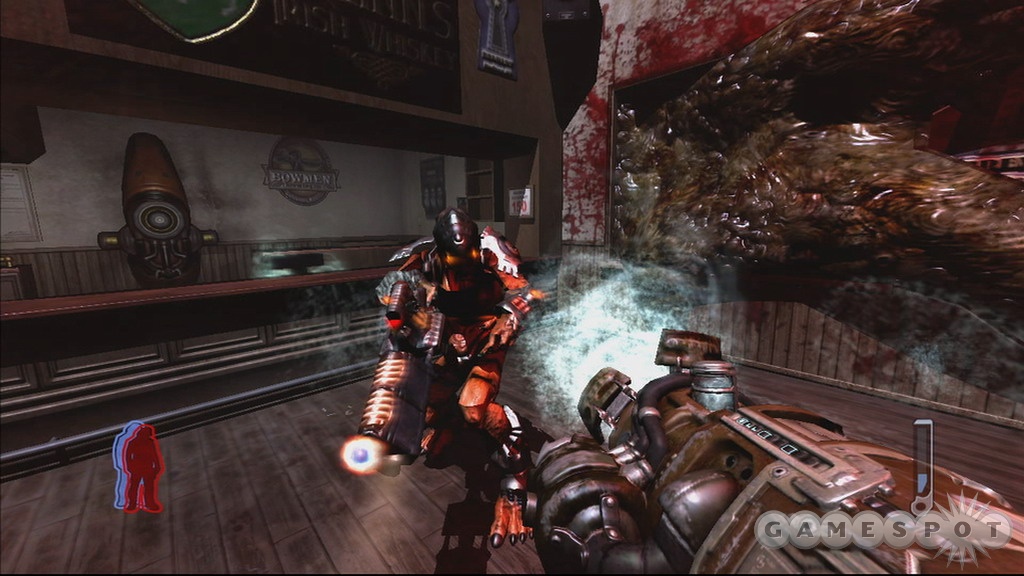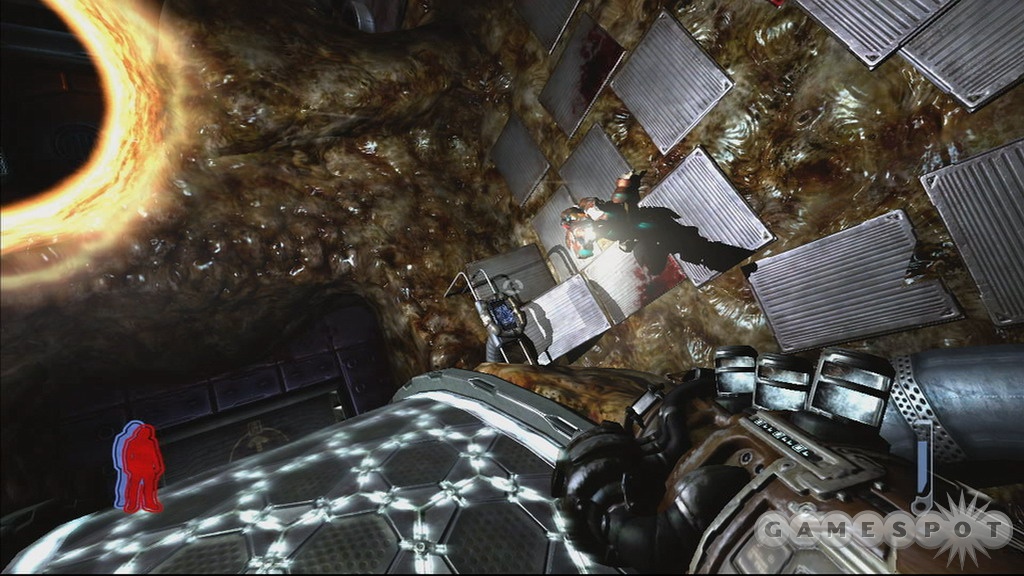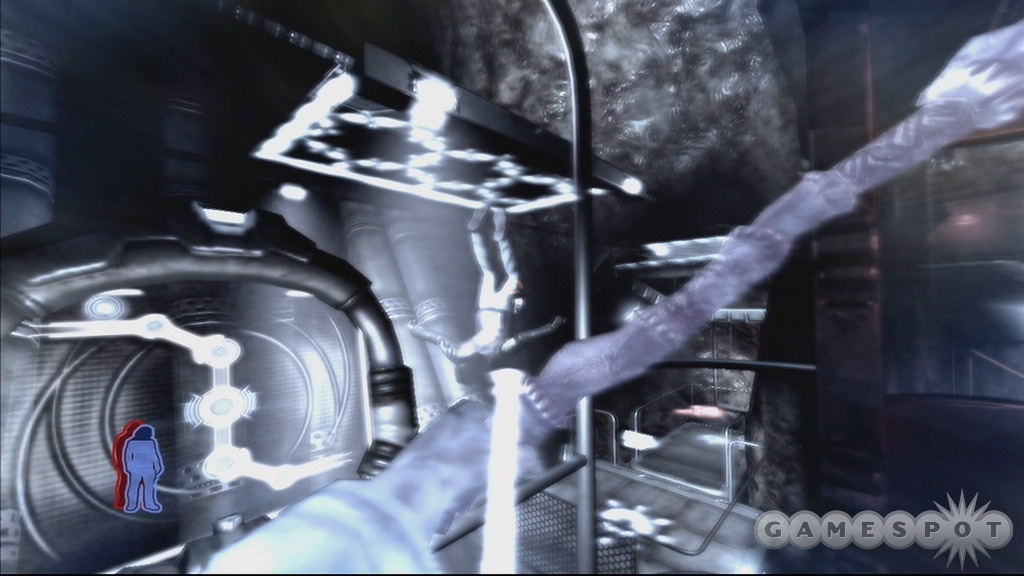A couple of years ago, you probably would have been branded as a lunatic if you had said that we'd ever get to play Prey. Many of the game's ideas were originally hatched a decade ago. The game was even shown off to press in 1997. But in 1998, Prey was canned so that the development team could move on to other projects, and it was assumed lost. It resurfaced last year with a new developer and new technology thanks to the engine that powered both Doom 3 and Quake 4. The end result is a pretty standard first-person shooter that offers up largely the same sorts of thrills you've probably come to expect from this style of game, in spite of some superficially novel twists.

Prey opens with the main character yelling at himself in a bathroom mirror. Tommy, a Cherokee Indian, doesn't really care about his heritage and wants to take his girlfriend, Jen, and leave the reservation. But before he can muster up the courage to convince her to leave (and just after he bashes in the skulls of a couple of morons causing trouble in her bar), an alien invasion sucks Tommy, his grandfather, and Jen up into some sort of spacecraft. With the help of some unknown benefactors, Tommy manages to get free and you set out on your quest to rescue your girlfriend and, of course, save Earth in the process. There are a few plot twists here and there, but some of those twists feel like they've been lifted directly from other games.
The two things that seem meant to separate Prey from its brethren are the game's liberal use of portals that bring you from place to place and a bag of gravity tricks that are meant to keep you wondering which way is up. The portals are open and let you see and fire weapons through to the other side. They lend themselves to a couple of neat tricks, including one where you see yourself entering a portal on the other side of the portal. Just try to resist the urge to shoot yourself in the back of the head. The portals are a neat idea, and their potential is revealed early on when you walk through one that shrinks you down and puts you inside a small glass case with a sphere inside. But for the rest of the game, the portals might as well be doors, because the linear level design rarely leaves you wondering if the portal that just appeared in front of you is indeed the right way to go.
Playing around with gravity is a much more interesting part of Prey. You'll encounter powered walkways that let you walk up walls and onto ceilings. Also, some portals will drop you into a room you've already been in, but you'll be walking on what you previously thought was a wall. And in a few other cases, you'll be able to shoot objects to change gravity, which forces your view to rotate as you fall to another surface. These segments of the game serve as the majority of its puzzles, but they aren't difficult to figure out.
The straightforward level design means that you'll spend the bulk of your time in combat. The game throws enemies at you pretty consistently, though their numbers are never overwhelming. And since the crazy aliens invented this portal business in the first place, they can teleport in rather than run around trying to find you. However, unlike the imps in Doom 3, Prey's hunters don't just teleport in behind you and attempt to catch you off guard, but also have a few basic evasive maneuvers at their disposal. That said, the game's artificial intelligence isn't particularly advanced. The hunters, armed with the same machine gun/sniper rifle combo that serves as your first real weapon, will occasionally take cover or toss a grenade in your direction if you're not in their line of sight, and they'll pick you off at a distance if you stand still in the open. But the rest of the enemies, a somewhat small menagerie of alien beasts and the occasional flying robot, stay out in the open and either rush right at you for a melee attack or attempt to circle around you and fire weapons, if they're armed. None of the enemies are difficult to deal with.
You are, of course, always armed. While you've got a pipe wrench at your disposal for melee attacks, it's useful only for the first couple of minutes. Then you take out your first hunter and get a rifle that fires like a machine gun but also has a scope that can be used for a more powerful sniper shot. All of the weapons are of alien origin, so many of them look kind of goofy and keep up the organic-merged-with-metal motif that the rest of the game is going for. For example, rather than having hand grenades, you pick up tiny crawling creatures that explode when you rip off one of their legs and toss them at an enemy. If you flip them over with the alternate fire button, you can plant them as mines or use them as Halo-like sticky grenades. You'll also get a rapid-fire nailgun-like weapon that works as a grenade launcher, an acid gun, and a rocket launcher that also fires a misty cloud that blocks weapon fire. Unfortunately, the mist also blocks your shots, which makes its use limited. You'll also get the leech gun. No, it doesn't fire leeches that bore into your enemies' flesh--that'd just be gross. Instead, you can leech power out of specific power terminals to charge your gun with energy. There are multiple energy types, so you might get hot-plasma shots, a freeze ray, a powerful burst of electricity, or, near the end of the game, a constant stream of energy that works roughly like Quake's lightning gun. While there are multiple weapons of varying power in the game, their alien look doesn't fit with their mostly conventional usage. On top of that, most of the game's enemies aren't tough enough to warrant that type of firepower. You could very easily cruise through the majority of the game using only the default rifle, since it has a recharging ammo supply.

Because Tommy's a mystical Cherokee warrior, he eventually gains another ability, even if he doesn't believe in mysticism. Early on in the game, you, as Tommy, gain the ability to leave your body and "spirit walk." In spirit form, you're armed with a bow that can be used to kill many enemies in one shot, but the real benefit of spirit walking is puzzle-oriented. To put it simply, you can walk through force fields when in spirit form. So anytime you see a force field, just punch the spirit walk button and walk on through. You can collect ammo and interact with switches and touch screens while in spirit form, so you'll usually use this form to turn off force fields, electric eyes, and other objects that get in your way. Some paths and walkways appear (and function) only when you're in spirit walk mode, so there will be some gaps that you can cross when you're outside of your body. Much like the game's other unique mechanics, it's an interesting idea that doesn't feel like it was fully explored for the purposes of the game.
Gaining the spirit walk power has one other benefit: When you die, you'll be sent directly to the spirit realm instead of to a game-over screen. This is essentially a basic minigame where you must fire the spirit bow at red and blue wraiths to recharge your health and spirit energy, respectively. After doing that for 15 to 20 seconds, you're sent back into the world of the living, right where you left off. This makes death trivial and removes any remaining difficulty you might encounter. In some ways, this method seems designed to remove the desire to constantly use quick saves and quick loads to inch through the game's 8- to 12-hour single-player campaign. Considering that the Xbox 360 version doesn't have any quick-save functionality, this process means that you can play through the game and manually save only when you decide to stop playing, because under normal circumstances, you'll never lose any progress--though it should be mentioned that both versions of Prey locked up a couple of times during play, which did, in fact, cause us to lose some progress. But since both versions autosave at the beginning of each level and the PC version auto-saves at checkpoints within the level, even this rare issue isn't enough to send you screaming for the save screen. One nice benefit of the game's death system is that the game only stops to load between levels. But it's only nice because many of the load times are close to a minute long.

A harder difficulty setting unlocks after you complete the main single-player game. It's sort of a shame that this isn't available right from the start, since it makes the combat a little more challenging. But since you can still do the death walk and refrain from losing progress when dying, the game is not worth playing through a second time, unless you're specifically trying to earn the Xbox 360 achievement you get for doing so. Speaking of achievements, Prey's are quite easy. You'll earn most of them by simply completing the single-player game. The multiplayer achievements include getting 25 kills with each of the game's weapons, scoring first place in a ranked match, playing in 10 ranked matches, and totaling up a number of kills in the game's two multiplayer modes. On top of that, there are three secret achievements, all of which are tied in to doing well at three video gambling machines that you run into at the very beginning of the game.
Both versions of Prey support multiplayer for up to eight players in two modes: deathmatch and team deathmatch. The maps are designed well enough, and they make better use of portals and gravity than the single-player game does, but ultimately, the weapons aren't much fun to fire and the limited number of modes makes the multiplayer feel like an afterthought. Deathmatch and team deathmatch have been done better elsewhere. Also, it's worth noting that the Xbox 360 version can only be played via system link or Xbox Live. There's no option for split-screen play.
The split between the Xbox 360 version and the PC version is fairly typical. The Xbox 360 version looks great and usually maintains a smooth frame rate, though it bogs down in a couple of specific spots. The PC version maintains its smooth frame rate throughout, provided you have a machine strong enough to handle it, and at higher resolutions it certainly looks better than its console counterpart. The Xbox 360 version benefits from the achievement points system, but it also carries a $59 price tag as opposed to the PC's $49 price. Both platforms also offer a limited-edition version that jacks up the price an additional 10 bucks and gets you two pewter figurines and an art book, which doesn't seem like a good value unless you have an interest in pewter figurines.
One of the selling points of Doom 3 and, later, Quake 4 was the strength of their visuals. The Doom 3 engine is also being used to power Prey, and the game maintains that standard of quality. The engine is capable of some interesting feats, but these feats are used only in limited circumstances. There are a few spots where you'll be in very large, open areas that give you an interesting sense of scale, but the majority of the game is a corridor crawl. There are a couple of cases where you'll see objects and even entire rooms being built right before your eyes, which looks cool, but you can count the number of times it happens on one hand. So while the majority of the effects are pretty understated, the game does get by on decent artistic design. Sure, it's mining the same organic-creatures-fused-with-machines territory that's been drawn from time and time again (in fact, it was done better by the last Doom 3 engine game, Quake 4), but the environments are visually interesting.

The weapons sound appropriate but lack punch. The game's soundtrack is also fine, though it rarely stands out. Strangely enough, the game's designers went out and licensed a whole bunch of real-world music for the jukebox in the bar that opens the game. You can click around and listen to great songs like "Barracuda" from Heart or Judas Priest's "You've Got Another Thing Comin'," but aside from a chance encounter later in the single-player and in some of the multiplayer, you never encounter these songs again. It seems like a waste. The game has plenty of voice work in it, and most of it's just fine. After you gain the ability to spirit walk, you can also understand the alien hunters, as they essentially start to speak English. While this gives you some tactical advantage--namely, you know when they're going to throw a grenade because they call it out--they sound dumb, and it lessens their impact as fearsome, unreasonable alien invaders.
Prey's campaign won't take too long, and it's rarely difficult, which makes it a solid choice if you're looking for an easy weekend romp. But much of the game's potential for unique thrills feels wasted by its straightforward level design, and the multiplayer doesn't add much to the package. Fans of the genre have probably played games better than Prey in the past, but the action and the environments you move through are interesting enough to make playing through the game worthwhile.